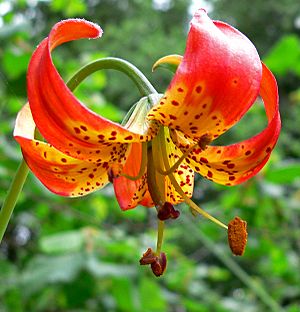Pitkin Marsh lily facts for kids
Quick facts for kids Pitkin Marsh lily |
|
|---|---|
 |
|
| Conservation status | |
| Scientific classification |
|
| Kingdom: | Plantae |
| Clade: | Tracheophytes |
| Clade: | Angiosperms |
| Clade: | Monocots |
| Order: | Liliales |
| Family: | Liliaceae |
| Genus: | Lilium |
| Species: | |
| Subspecies: |
L. p. subsp. pitkinense
|
| Trinomial name | |
| Lilium pardalinum subsp. pitkinense (Beane & Vollmer) Skinner
|
|
The Pitkin Marsh lily (scientific name: Lilium pardalinum subsp. pitkinense) is a beautiful and very rare plant. It's a type of lily that grows back every year, like many flowers. This special plant is found only in certain wet areas in northern California, specifically in Sonoma County. It's a subspecies, which means it's a unique kind of the larger Lilium pardalinum or Leopard lily. Sadly, it's an endangered plant, meaning it's at risk of disappearing forever.
Contents
Where the Pitkin Marsh Lily Lives
The Pitkin Marsh lily grows in a very specific area. It likes freshwater marshes and wet meadows in western Sonoma County, Northern California. These plants are found at a low elevation, usually between 35 to 60 meters (about 115 to 197 feet) above sea level.
Today, we only know of a few places where this rare lily still grows. One important spot is the Pitkin Marsh, which is near California State Route 116 between the towns of Sebastopol and Forestville, California. This marsh is also home to another rare plant called the white sedge.
Scientists believe that in the past, the Pitkin Marsh lily grew in more places across the wetlands of Sonoma County, including areas like the Laguna de Santa Rosa. There were likely many more of these plants back then.
What the Pitkin Marsh Lily Looks Like
The Pitkin Marsh lily can grow quite tall, reaching between 1 to 2 meters (about 3 to 6.5 feet) high. Its leaves are usually around 14 centimeters (about 5.5 inches) long and 1 to 2 centimeters (less than an inch) wide.
The leaves grow in circles, or whorls, around the stem. They are shaped like long ovals. Sometimes, near the Pitkin Marsh, you might see lilies that look like a mix between the Pitkin Marsh lily and the closely related Panther lily. This happens when two similar plants create a hybrid.
This lily blooms in June and July. Its Petals are bright red on the edges and turn yellow towards the center. They also have small, dark maroon dots. The parts of the flower that hold pollen, called anthers, are purplish-brown.
You can tell the Pitkin Marsh lily apart from its common relative, the Leopard lily, because the Pitkin Marsh lily has shorter petals and anthers.

Protecting the Pitkin Marsh Lily
The Pitkin Marsh lily is a very important plant to protect. The United States government officially listed it as an endangered plant in 1997. The State of California had already classified it as endangered in 1978.
The places where this rare plant lives have shrunk a lot over time. One big reason is too much cattle grazing, where cows eat too many plants. People also used to collect these beautiful lilies because they were rare, which further reduced their numbers. Today, the main threats are still cattle grazing and changes to the water flow and quality in the wetlands.
Status of Known Lily Groups
There are only three groups of Pitkin Marsh lilies that we know are still growing in the wetlands of western Sonoma County.
- First Group: Researchers haven't been able to visit the land where the first group lives since 1975. We hope the plants are still there, but we don't know how many are left.
- Second Group (Pitkin Marsh): This group almost disappeared in the 1960s because of building plans. Luckily, about 200 plants still remain. There are still plans for building nearby, but an agreement with the California Department of Fish and Game is helping to protect this important group of lilies. Recently, a plan to build a care facility on part of the marsh was put forward, and the county is still deciding on it.
- Third Group: At this location, where the lily used to be common, only two plants are left. This happened because the wetland was filled in, and also because people collected the plants and their bulbs for gardening. The owners of this land and the Pitkin Marsh land agreed to protect the lilies with The Nature Conservancy in 1989.
- Fourth Group: This group is found in Ragle Ranch Regional Park in Sebastopol, California. There are several plants here, but their numbers are going down because they are in a busy part of the park.
- Fifth Group: This group is in a forest northeast of the town of Bodega. We don't know how they are doing right now.


